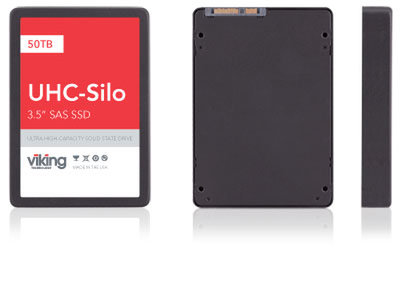SSDs are all about performance density, which means packing the most capacity and performance into the smallest footprint possible. To that end, Viking Memory wheeled out its 50TB UHC-SILO SSD. Unlike the larger 60TB prototype Seagate demonstrated at last year’s Flash Memory Summit, Viking’s model is actually already shipping to customers.
To accommodate the drive’s beefy capacity, Viking stuffed the flash into a 3.5″ enclosure. Surprisingly, the SSD uses standard Sk Hynix planar (2D) NAND instead of denser 3D NAND. That doesn’t mean you can slap it in your desktop PC, though, unless you’re running a SAS RAID controller. The UHC-SILO sports a dual-port 6Gb/s SAS connection, which means it offers failover and multi-pathing features, but that restricts overall performance.
The SSD provides up to 60,000/15,000 random read/write IOPS and up to 500/530MB/s of sequential read/write throughput. That puts it on par with many enthusiast-class SATA SSDs, but Viking’s real goal is to reduce power consumption. The SSD sips 16W of power, which the company claims can reduce costs by up to 80% per TB. Viking hasn’t disclosed the controller vendor, so it’s hard to speculate if the SSD would work faster with other interfaces. We are sure to learn more details at this year’s Flash Memory Summit, which is just a few weeks away.
Planar NAND, while not as dense as 3D NAND, provides solid endurance metrics. The UHC-SILO offers 1 DWPD (Drive Write Per Day) of endurance for five years. That means you can write up to 91.25PB of data to the drive and stay within warranty coverage.
Viking hasn’t listed pricing, but it certainly falls into the “if you have to ask” category. Considering today’s prices, we’re looking in the range of $18,000, and that’s before the enterprise markup. Data centers are steadily moving to higher-density SSDs, but a 50TB SSD is still sure to be a rarity. Viking also offers a 25TB model if you can’t pony up enough cash for the flagship.
If you want to see some of the other “World’s Largest” SSDs, head over to this article from last year’s Flash Memory Summit.
